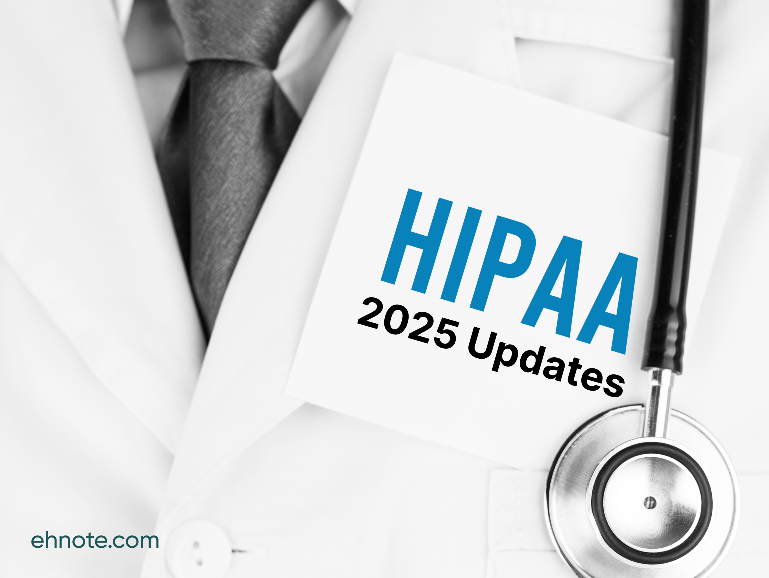HIPAA Updates 2025: What Eye Care Providers Need to Know (And How to Stay Ahead)

Keeping up with HIPAA regulations feels like trying to hit a moving target. Just when you think you’ve got a handle on patient privacy rules, new updates roll out.
With 2025 here, the Department of Health and Human Services (HHS) is tightening requirements to address emerging risks like cybersecurity threats and telehealth vulnerabilities. For ophthalmologists, these changes aren’t just red tape; they’re critical to protecting your practice and your patients.
In this article, we’ll break down the key HIPAA updates for 2025, explain how they’ll impact your day-to-day workflows, and share practical steps to stay compliant without drowning in paperwork.
What’s Changing in HIPAA 2025?
The 2025 updates focus on three areas: strengthening cybersecurity, expanding patient rights, and closing gaps in telehealth compliance. Here’s what you need to know:
1. Stricter Cybersecurity Protocols
Multi-Factor Authentication (MFA) Required: All systems accessing electronic Protected Health Information (ePHI) must use MFA. This means no more relying solely on passwords for your EHR or billing software.
Annual Third-Party Risk Assessments: If you use cloud-based tools (like most modern practices do), you’ll need documented proof that vendors meet HIPAA’s updated security standards.
Faster Breach Reporting: The window to report breaches affecting 500+ patients drops from 60 days to 30 days.
2. Patients Gain More Control Over Their Data
Shorter Response Times: Patients can request their records (e.g., surgical reports, visual field test results) and you’ll need to provide them within 15 days (down from 30).
No More “Reasonable Fees”: Charging patients for copies of their records? The HHS is cracking down on fees deemed excessive, pushing for free or low-cost access.
3. Telehealth Rules Get Specific
Home Network Security Guidance: If you’re diagnosing dry eye or reviewing post-op recovery via telehealth, you must advise patients on securing their home Wi-Fi networks.
Encryption Mandates: Platforms used for virtual visits must meet higher encryption standards to prevent eavesdropping.
How These Updates Will Impact Your Practice
You didn’t go into ophthalmology to become a cybersecurity expert, but HIPAA’s 2025 changes mean security and compliance can’t be an afterthought. Here’s where small to mid-sized practices often struggle:
Time-Consuming Audits: Manually checking vendor compliance (e.g., your EHR, billing software, or cloud storage provider) eats into clinic hours.
Patient Requests Overload: Faster record turnaround times could strain your staff if you’re still using paper charts or siloed systems.
Telehealth Vulnerabilities: Older platforms might not meet encryption standards, putting virtual visits at risk.
Practical Steps to Prepare (Without the Panic)
1. Start with a “Security Checkup”
Enable MFA on every tool that touches ePHI—including your EHR, practice management software, and email.
Ask vendors for their 2025 HIPAA compliance reports. If they can’t provide one, it’s time to shop around.
2. Simplify Patient Record Access
Use a patient portal that lets patients download their records (e.g., surgical notes, refraction results) instantly.
Train staff on handling record requests within the 15-day window. Pro tip: Automate reminders to avoid missed deadlines.
3. Audit Your Telehealth Workflow
Ditch platforms that lack end-to-end encryption. Look for tools specifically designed for healthcare (Zoom won’t cut it).
Add a script for telehealth visits: “For your security, please ensure you’re on a private network during this call.”
How EHNOTE Supports HIPAA 2025 Compliance
At EHNOTE, we build ophthalmology-specific tools with privacy and security as default settings—not add-ons. Here’s how we help reduce the heavy lifting:
Built-In MFA and Encryption: Every login to our EHR and practice management platform requires MFA, and data is encrypted at rest and in transit.
Patient Portal with Self-Service Access: Patients can download their records (e.g., visual field tests, IOP readings) instantly, eliminating back-and-forth emails.
Built-In Compliance for ASCs: From surgical logs to anesthesia records, our ASC tools adhere to HIPAA’s strictest documentation standards.
The Bottom Line
HIPAA’s 2025 updates are a reminder that patient trust is built on transparency and security. By taking proactive steps now—like adopting secure, patient-centered tools—you can focus less on compliance headaches and more on what matters: delivering exceptional eye care.
Need help simplifying HIPAA compliance?
Explore how EHNOTE’s ophthalmology-specific platforms are designed to adapt to changing regulations—so you don’t have to. Learn more about our security features here.
